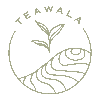Tea 101: The Famous Darjeeling
As a tea drinker and admirer of tea plantations, I've always dreamed of visiting. And this May, I'll be fortunate enough to finally travel there! But before diving into my trip itinerary, I've highlighted the most important points about Darjeeling below. Let's call it: Darjeeling 101.
Tea Harvesting & Characteristics
The tea harvesting season lasts a little over seven months, from March to October. It is also divided into four distinct periods called "flushes". The First Flush takes place in March & April, the Second Flush in May & June, the Third Flush in July & August, and the Fourth Flush in September & October. Of course these are subject to local weather and crop conditions, but it usually works out to this timing.
Estates, or "tea gardens", in Darjeeling boast an elevation range from around 2000 to even 6900 ft (in the case of the Happy Valley Tea Estate), which is why images of the gardens are typically very steep and enshrouded in a beautiful layer of mist.
Due to its high altitudes and nutrient-rich soil, Darjeeling tea is known for its distinctively muscatel flavours and floral aromas. Each flush carries the same signature and magical Darjeeling taste but with noticeable differences.
Traditionally, black tea is produced. However, in recent years Darjeeling has also been experimenting with Oolong, Green and even White tea to a remarkable success.

Photo by Tanveer Badal
Four Distinct Flushes
The First Flush (aka the "Spring Flush") is picked in March after the tea bushes have had their beauty rest over winter, allowing the tea tree to revitalize and re-gain its nutrients. This results in a delicate, tender leaf, which steeps a light amber liquor and is highly aromatic. Because the leaves only remain in this tender state for a short period of time, the First Flush yield is much lower than others, making it a rare and highly sought-after commodity. In fact, the best First Flush teas sometimes fetch prices over US$1000 per kilo!
In contrast, the Second Flush, or "Summer Flush" produced in May and June, while carrying a lower price tag, usually represents over 40% of sales due to high crop yield and appeal. A summer flush is bolder, darker in colour and carries more complex, fruity flavours. After having tried both, I can't say one is better than the other! Both are fine teas which I will choose between based on my mood.
Then you have the Third Flush, or "Monsoon Flush" in July and August. In Darjeeling heavy rains fall during these months. After the rains stop, the tea plants start growing again, producing harvestable leaves that many gardens use for teabags and blends due to their stronger flavor. The leaves are plentiful but considered lower quality, steeping a dark tea liquid with a slightly dull flavor.
Finally, we come to the "Autumn Flush" that is harvested in September and October, when the monsoon season ends and the tea plants resume growth. The Autumn leaves are darker and larger in size, steeping a full-bodied and naturally fruity flavored tea. With a coppery colored liquid and a nice round taste, the Autumn flush is stronger than the Second Flush and can be enjoyed as breakfast tea.
Tea Trade & Tourism
So there's the breakdown of the product. How about the trade?
The Darjeeling estates produce over 9 million kg of tea per year, generating up to nearly US$80m in annual sales. It also engages about 50 percent the people of Darjeeling district, making it a very important industry and lifeblood of the region.
However, as a secondary source of income, the gardens have been turning to tourism in recent years. Yes - that's right. You can now visit the Darjeeling tea gardens and enjoy a very comfortable stay! Following the footsteps of the Glenburn Tea Estate, several tea gardens have converted their historical bungalows, formerly housing resident British planters, into luxury accommodations. Preserving their heritage colonial style, these tea gardens also offer tea tours where guests have the chance to try their own hand at plucking tea leaves and participate in tea tastings!

Photo by Glenburn Tea Estate
For my upcoming trip in May, I'm looking into a homestay option at the highly-esteemed Makaibari Tea Estate, that has its core values in supporting its people. This option allows guests to stay in the homes of local families of the tea gardens, providing an unparalleled cross-cultural and educational experience. In a beautiful example of sustainable tourism, the profits of this homestay program are shared between the members of the community who participate and go directly to the families.
Keep an eye out for my next blog post, where I dive into this wonderful homestay program in more detail and share the awesome trip activities I have in store!
Afterthought
So there you have it: My short-but-sweet introduction to Darjeeling and its wonderful teas! I hope reading this has helped you understand more about the region and has made you excited to try some of their teas.
Have any of you tried Darjeeling tea before? What are your thoughts? Feel free to comment and ask questions below!
♥

Leave a comment